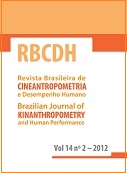The general functional fitness index and symptoms of depression in older adults
DOI:
https://doi.org/10.1590/1980-0037.2012v14n2p125Abstract
Depression is considered the most common mental health disorder in older adults. Studies have shown that physical activity can reduce depressive symptoms in this population with immediate clinical effects. The objective of this study was to analyze the association between symptoms of depression and General Functional Fitness Index (GFFI) in elderly physical exercise practitioners. The Geriatric Depression Scale of Yesavage (GDS-15) was used to evaluate the presence of depressive symptoms, and the AAHPERD (American Alliance for Health, Physical Education, Recreation and Dance) fitness test battery for assessment of GFFI. We used descriptive statistics and Pearson correlation with 95% confidence intervals. The population consisted of 146 elderly participants of the Floripa Ativa Program - Phase B, with the sample consisting of 77 older adults with a mean age of 67.9 (SD 5.7) years. Among them, 13 exhibited symptoms of depression and 33 were fit, with the GFFI within normal range. We found a negative (r = -0.307) and significant (p = 0.007) correlation between GDS and GFFI. This inversely proportional relationship demonstrates that subjects with a better GFFI had a lower incidence of depressive symptoms. As the GFFI value is obtained through physical tests, it can be suggested that physical exercise supported the reduction of depressive symptoms in the study group.



